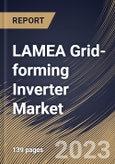Inverters provide the interface between grid and energy sources like solar panels, wind turbines, and storage. Conventional inverters will turn off the electricity to these energy sources whenever there is a significant disruption or outage on the grid. They will then wait for a signal from the rest of the grid indicating that the disruption has been resolved and that it is safe to restart. This process is referred to as "grid-following." As wind and solar account for increasing shares of the overall electricity supply, it is becoming impractical to depend on the rest of the grid to manage disturbances. Grid-forming inverters are a relatively new technology that, when combined with other inverter-based energy sources, can allow solar power to independently restart the power grid.
The fast growth of infrastructure for charging electric vehicles (EVs) is driving up demand for smaller power distribution networks (microgrids). Microgrids offer a feasible solution by integrating localized power generation and distribution, effectively managing the additional electricity load from EV charging. Grid-forming inverters are a key technology component in microgrids, especially in islanded mode where the microgrid operates independently from the main grid.
Microgrids alleviate grid congestion and mitigate the need for costly grid upgrades by optimizing energy generation, distribution, and load management. In addition, electric vehicle charging stations are often a contributor to times of peak demand, which results in increased electricity bills. Microgrids that are outfitted with sophisticated load management capabilities enable effective charging schedule optimization and load balancing. This helps to reduce peak demand, which in turn improves grid stability and lowers overall charging costs.
The Dubai Water and Electricity Authority (DEWA) projects that by 2025, there will be 12,852 electric vehicles operating in Dubai, up from an estimated 7,331 in 2023. This supports Dubai's Green Mobility Strategy 2030, which mandates that by 2030, 30% of public sector vehicles and 10% of all vehicle sales must be electric or hybrid. Therefore, with rise in the number of electric vehicle and usage of renewable energy, the grid-forming inverter market is estimated to grow.
The Brazil market dominated the LAMEA Grid-forming Inverter Market by Country in 2022, and would continue to be a dominant market till 2030; thereby, achieving a market value of $23.1 million by 2030. The Argentina market is showcasing a CAGR of 12.7% during (2023-2030). Additionally, The UAE market would grow at a CAGR of 11.8% during (2023-2030).
Based on Application, the market is segmented into Solar PV Plants, Wind Power Plants, Energy Storage Systems, and Electric Vehicles. Based on Type, the market is segmented into Central Inverter, Micro Inverter, and String Inverter. Based on Voltage, the market is segmented into Above 500 V, 300 - 500 V, and 100 - 300 V. Based on Power Rating, the market is segmented into Below 50 KW, 50 - 100 KW, and Above 100 KW. Based on countries, the market is segmented into Brazil, Argentina, UAE, Saudi Arabia, South Africa, Nigeria, and Rest of LAMEA.
The market research report covers the analysis of key stakeholders of the market. Key companies profiled in the report include Huawei Technologies Co., Ltd. (Huawei Investment & Holding Co., Ltd.), SolarEdge Technologies, Inc., Enphase Energy, Inc., Schneider Electric SE, General Electric Company, Delta Electronics, Inc., Sungrow Power Supply Co., Ltd., Fimer Group, KACO new energy GmbH and GoodWe.
Scope of the Study
By Application
- Solar PV Plants
- Wind Power Plants
- Energy Storage Systems
- Electric Vehicles
By Type
- Central Inverter
- Micro Inverter
- String Inverter
By Voltage
- Above 500 V
- 300 - 500 V
- 100 - 300 V
By Power Rating
- Below 50 KW
- 50 - 100 KW
- Above 100 KW
By Country
- Brazil
- Argentina
- UAE
- Saudi Arabia
- South Africa
- Nigeria
- Rest of LAMEA
Key Market Players
List of Companies Profiled in the Report:
- Huawei Technologies Co., Ltd. (Huawei Investment & Holding Co., Ltd.)
- SolarEdge Technologies, Inc.
- Enphase Energy, Inc.
- Schneider Electric SE
- General Electric Company
- Delta Electronics, Inc.
- Sungrow Power Supply Co., Ltd.
- Fimer Group
- KACO new energy GmbH
- GoodWe
Unique Offerings
- Exhaustive coverage
- The highest number of Market tables and figures
- Subscription-based model available
- Guaranteed best price
- Assured post sales research support with 10% customization free
Table of Contents
Companies Mentioned
- Huawei Technologies Co., Ltd. (Huawei Investment & Holding Co., Ltd.)
- SolarEdge Technologies, Inc.
- Enphase Energy, Inc.
- Schneider Electric SE
- General Electric Company
- Delta Electronics, Inc.
- Sungrow Power Supply Co., Ltd.
- Fimer Group
- KACO new energy GmbH
- GoodWe
Methodology

LOADING...








